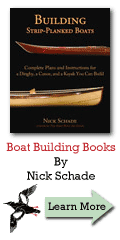> Mike,
> I'm using clear recycled red fir. Had a 21' 2x10 lying around with some
> rot/damage. Had to rip it on the radial arm saw because my shop isn't long
> enough where the table saw sits but I could go in one door and out another
> with the radial saw. Got 5-21' strips, 1-17', 2-13', and 1-12'. I cut the
> strips 1/2"x1" and they're quite flexible. I don't know if I
> need to be concerned about flexibility as the boat's intended use is for
> small local lakes. As a novice (I''ve never been in a kayak) I don't even
> know what flexibility does for you. One other question: There are some
> pitch pockets--mostly dry. I plan to fill with putty and seal with shellac
> before finishing the frame. Do you think I'm on the right track there?
> Thanks, Tom
The `bridgework` or cross bracing that goes between those long strips will stiffen things considerably, but the frame should still flex nicely. It should bend, and not break.
As for the pitch pockets. I would not use putty to fill them. Nor would I bother sealing with shellac. The frame is pretty much hidden from sight, so cosmetic fixes are irrelevant. The issue is strength, not looks. If the area looks significantly weaker then epoxy glue, or glue and screw, a block of wood inside of the boat to reinforce these areas. In his book, Putz has a picture of how this is done.
Putz suggests a linseed oil mix for sealing and preserving the wood. This should work fine, and soak in well if you DO NOT have the wood sealed with shellac. So don't bother with shellac.
The frame for a prototype of a folding kayak has been sitting outside for a while, waiting for me to finish it. I started sealing the wood with a coat of epoxy a few years ago. I thought I had it completely covered, but when I went to put a coat of varnish on this, I discovered I had not gotten the bottoms of the wood strips, and some of the frames. I figured I could get away with just varnishing these. A year later I could very easily see the difference between the spots that had been varnished, and those that had been sealed with epoxy and then varnished. The un epoxied wood had weathered MUCH more than the epoxy coated areas. From now on I'll seal the wood with epoxy.
I'm tempted to do this BEFORE I assemble the pieces. I can lay the long, straight strips side-by- side and paint on the epoxy rather quickly. After the boat is assembled I can touch up the cut ends.
I'm fortunate in that I have some excess epoxy from stripbuilding projects. The linseed oil method is much cheaper, otherwise.
Hope this helps
Paul G. Jacobson
Messages In This Thread
- Walrus stems
Tom Kurth -- 10/29/1999, 9:00 pm- Re: Walrus stems
Mike Hanks -- 10/29/1999, 11:29 pm- Re: Walrus stems
Tom Kurth -- 10/30/1999, 9:00 am- Re: Walrus stems
Paul G. Jacobson -- 10/30/1999, 8:32 pm - Re: Walrus stems
Mike Hanks -- 10/30/1999, 10:09 am
- Re: Walrus stems
- Re: Walrus stems
- Re: Walrus stems



